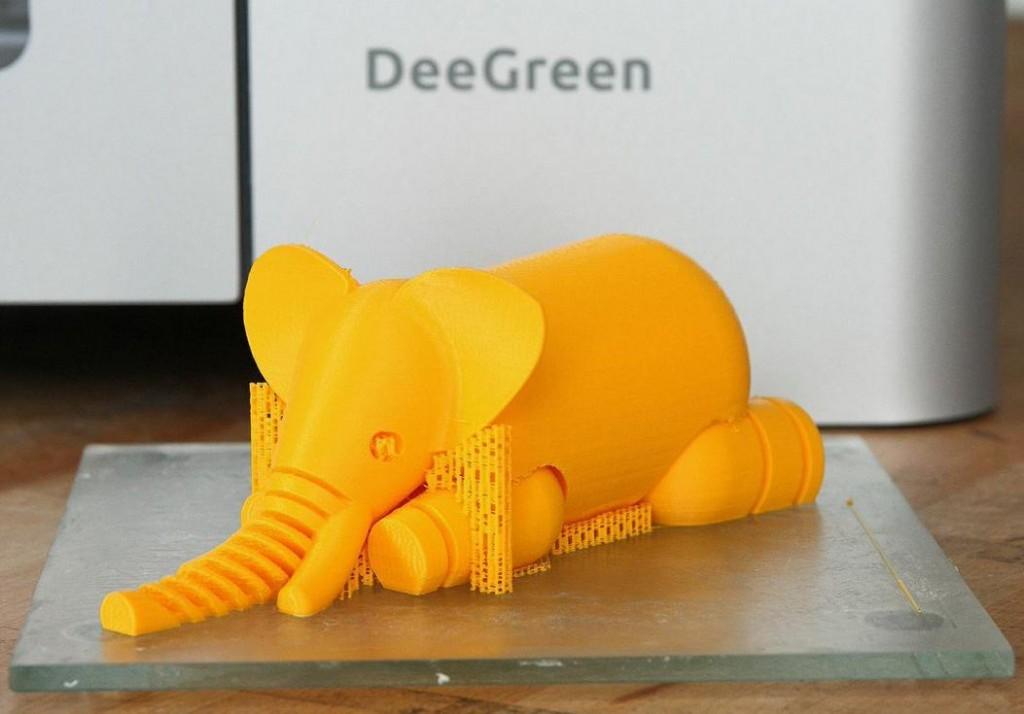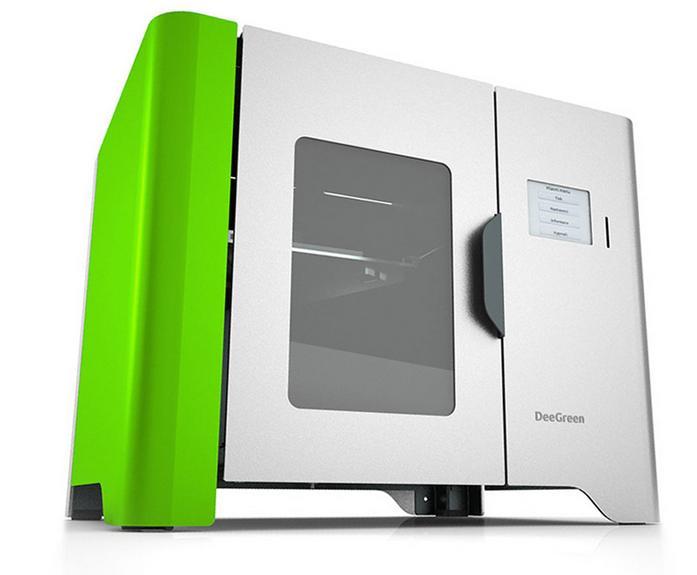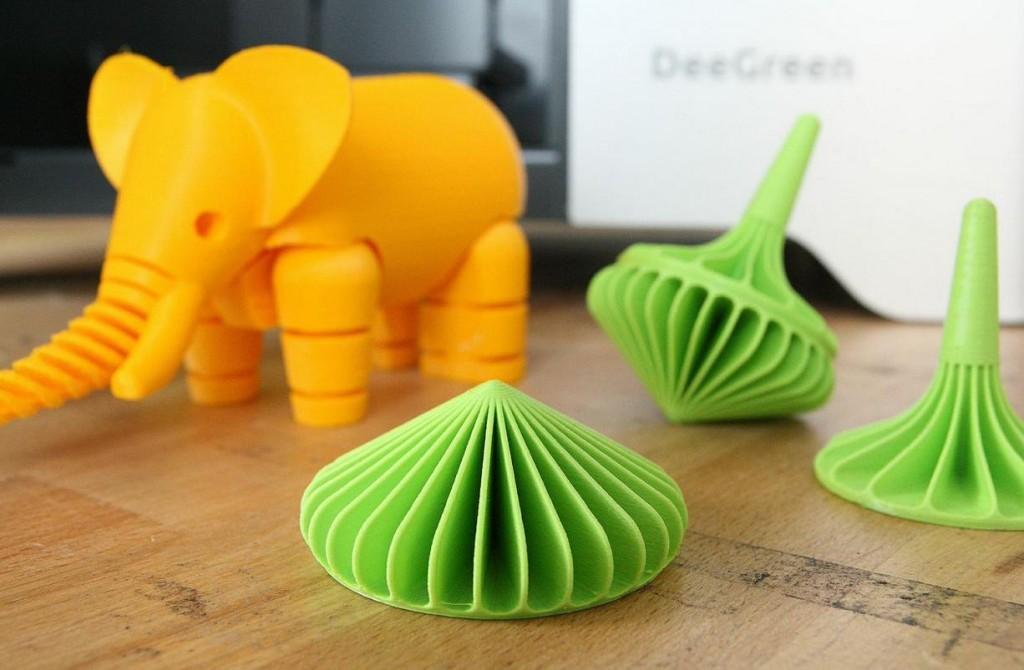I have had the chance to see dozens of different 3D printers in action. I have had the opportunity to fidget with numerous machines, and usually I walk away saying, “3D printing still has a long way to go before it’s in everyone’s homes.” Why, you may ask? The answer is quite simple. The majority of the 3D printers on the market today require practice; practice on leveling a build plate, calibrating the hardware, running numerous tests for extruder temperature settings, and quite simply lots and lots of trial and error. When most people buy a 3D printer, they aren’t expecting it to be this complicated. They are expecting it to be as simple as plugging in their 2-dimensional inkjet printer, hitting print on a computer screen and getting quality results. This is how it should be, but unfortunately not how it usually goes.
be3D was kind enough to supply us with a DeeGreen 3D printer to test out. They were bringing their product to America, and wanted to show it off on a grand scale. I was hesitant at first to agree to do this review, simply because I don’t have very much time on my hands. Between running this site, writing articles daily, and spending time with my 11-month old son and my wife, I just didn’t feel like having the burden of setting up and testing yet another 3D printer. However, the nice fellow at be3D was persistent enough, as well as very accommodating. I agreed to test out their DeeGreen 3D printer, and boy was I surprised.
The box arrived at the office, and I immediately put it aside, telling myself that I would get to it when I had half a day to spare. This is because I know how long setting up, calibrating and getting used to a new 3D printer can be. A few days passed, and I was home alone on the weekend. I had several hours free and decided give the DeeGreen a shot. I pulled it out of the box, and immediately notice how heavy it was. This printer was made of solid metal, which really surprised me. I have been used to taking 3D printers out boxes, only to be disappointed by their light weight, plastic body styles, reminiscent of something found in a child’s play kitchen set. The DeeGreen certainly was not that. In fact, it weighs 48.5 lbs and was quite heavy to pull out of the box by myself, regardless of my daily weight training regime.
Once the DeeGreen was out of the box, I plugged it in, installed the software and put a little glue on the glass build plate. The provided software was extremely easy to understand, and it was all very automated. I simply loaded in a 3D file of an elephant, which I downloaded from Thingiverse, and less than 2 minutes later it was ready to print. The software allows for a seamless conversion and flawless slicing of .STL files, all at the touch of a button. I pressed print, and was surprised that it didn’t even ask me for a temperature setting. I later realized that these can be changed, but the default settings seem to have worked quite well with all the PLA I have printed with thus far. After the print command is sent to the printer, the automated bed leveling system begins testing the level of the glass print platform. This took about 45 seconds and then the print process began.
Nervously watching as the first layer was laid down, I was astonished at just how quick and easy the process was. In all honesty, I can say that it was just as simple as printing a document on my inkjet 2-dimensional printer, and the entire process, from downloading the file to beginning the print, took me a total of four and a half minutes. This was the first time I ever took a 3D printer out of the box, and it was up and printing within 10 minutes time. I was thoroughly impressed. After a couple hours of printing, my mini elephant was all done, and quite frankly it came out perfect.
Pinching myself, as I really had a hard time believing how simple, easy, and quick that entire process went, I loaded in some more models to make sure that this wasn’t a fluke. All in all, I have run about a dozen print jobs so far, and have only had one failed print. That one instance was the case of me putting unspooled filament into the printer, and it getting tangled up among itself. This by no means was the fault of the DeeGreen.
If I were asked what the worse thing was with this printer, I would have a hard time providing an answer. Everything about it screams “quality,” “ease of use,” and “fun.” Some may say that it is priced a bit hefty, at $1,999. It will cost you more money than a lot of other 3D printers that have recently come to market, but I’ll tell you that you certainly get what you pay for. One thing I would prefer would be a larger build volume, as the largest item you can print on this printer is 5.9 x 5.9 x 5.9 inches. It’s not ridiculously small like some 3D printers I’ve seen, but I wouldn’t mind another few inches in all three directions.
As for the hardware itself, the entire printer is fully enclosed. It features a door on the front for access to the build area, as well as a door on the right hand side for a spool of filament. Filament is fed through a tube and loading/unloading it is very simple. It is all automated through the on board touchscreen controller. There is glass located on the front door of the machine, to allow the person printing to closely watch the object as it is built upon, layer by layer. The printer will not print if either door is opened or if the lid is not on correctly. This ensures that no one can reach inside mid-print and hurt themselves, and that no fumes can escape. The touchscreen monitor shows a status bar, depicting how far along in the print process you are. I have found this to be extremely accurate and it has helped me determine how much time I had left before my object was ready.
 The removable print bed makes it extremely easy to remove prints. I’ve never had any issues and have used glue sticks to adhere objects to the plate every time. Once the plate is removed, objects can be taken off with a quick slide of a scraper between the plate and the object.
The removable print bed makes it extremely easy to remove prints. I’ve never had any issues and have used glue sticks to adhere objects to the plate every time. Once the plate is removed, objects can be taken off with a quick slide of a scraper between the plate and the object.
Here are some more specifications on the be3D DeeGreen 3D Printer:
- Printing field: 5.9 x 5.9 x 5.9 in (150x150x150mm)
- Accuracy X/Y: +/- 0.003 in
- Accuracy Z: 0.003 / 0.005 / 0.007 in
- Nozzle diameter: 0.015 in
- Weight: 48.5 lbs
- External dimensions 19.4 x 15.5 x 15.3 in. (495x395x390mm)
- Maximum speed: 3.54 in / s (90 mm / s)
- Printer control: Touchscreen
- Interior lighting: LED
- Printable material: PLA, Woodfill (0.068 in), (supposedly can also work with ABS, but not recommended)
- Inputs USB, SD card
This printer is not a joke. It is very capable, and very easy to use. If you can afford the $1,999 price tag and you prioritize “ease of use,” I would highly recommend grabbing a DeeGreen 3D printer. You won’t be disappointed. Parts of this review may seem a bit dramatic, as I must admit I am quite exited about this 3D printer. Note: DeeGreen did not pay for this review, it is an honest review, that I myself will stand by.
Have you used a DeeGreen 3D printer? What do you think of this piece of hardware? Discuss in the Be3D DeeGreen Forum thread on 3DPB.com.
Subscribe to Our Email Newsletter
Stay up-to-date on all the latest news from the 3D printing industry and receive information and offers from third party vendors.
You May Also Like
Gorilla Sports GE’s First 3D Printed Titanium Cast
How do you help a gorilla with a broken arm? Sounds like the start of a bad joke a zookeeper might tell, but it’s an actual dilemma recently faced by...
Nylon 3D Printed Parts Made More Functional with Coatings & Colors
Parts 3D printed from polyamide (PA, Nylon) 12 using powder bed fusion (PBF) are a mainstay in the additive manufacturing (AM) industry. While post-finishing processes have improved the porosity of...
$25M to Back Sintavia’s Largest Expansion of Metal 3D Printing Capacity Since 2019
Sintavia, the digital manufacturing company specializing in mission-critical parts for strategic sectors, announced a $25 million investment to increase its production capacity, the largest expansion to its operations since 2019....
Velo3D Initiates Public Offering in a Bid to Strengthen Financial Foundations and Drive Future Growth
Velo3D (NYSE: VLD) has been among a number of publicly traded 3D printing firms that have attempted to weather the current macroeconomic climate. After posting a challenging financial report for 2023,...


































